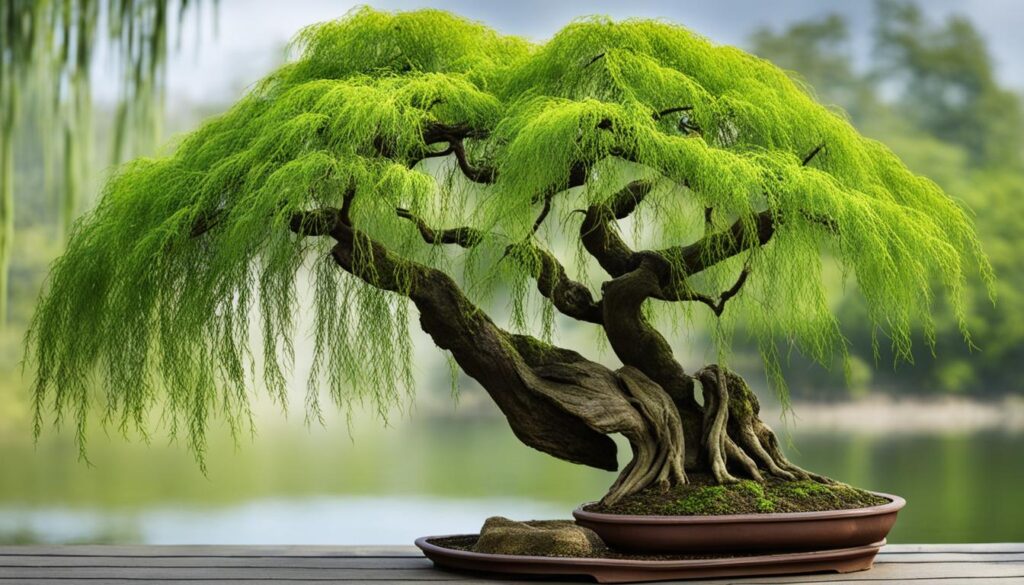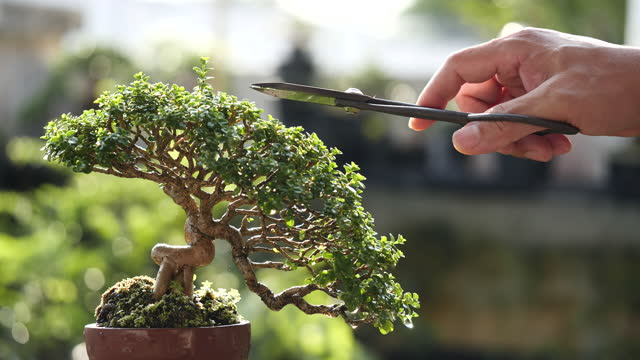If you’re looking for a stunning addition to your indoor bonsai collection, the weeping willow bonsai (Salix babylonica) is a perfect choice. In this comprehensive care guide, we will explore everything you need to know to ensure the health and vitality of your weeping willow bonsai.
From bonsai care techniques to selecting the perfect bonsai tree, we’ve got you covered. Whether you’re a seasoned bonsai enthusiast or just starting your bonsai journey, this guide will provide valuable insights and tips to help you succeed.
So, let’s dive in and discover the enchanting world of weeping willow bonsai!
Key Takeaways
ToggleDiscovering the Enchanting World of Weeping Willow Bonsai
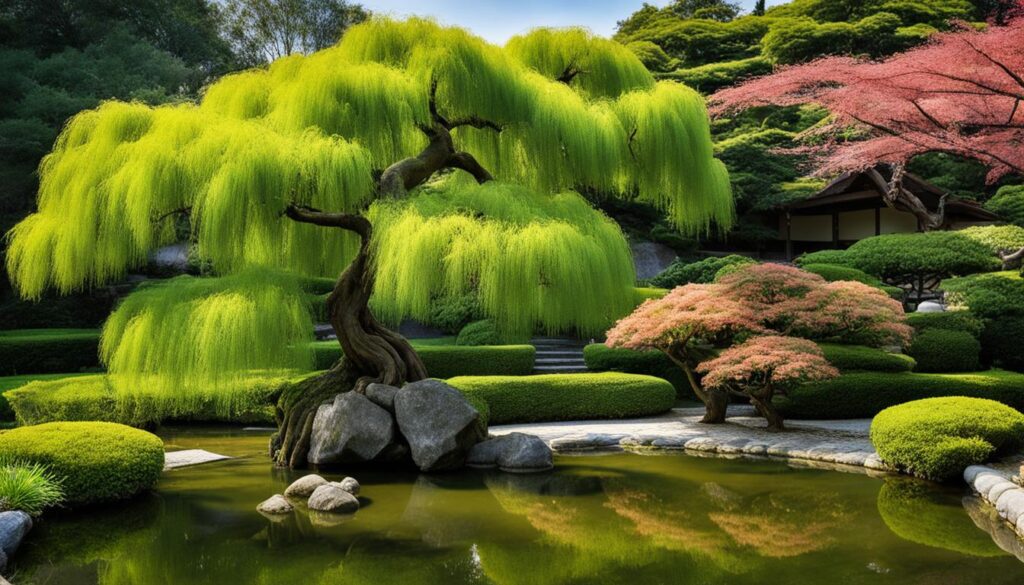
History and Popularity of Weeping Willow Bonsai
Weeping Willow Bonsai has a rich and fascinating history that dates back centuries. Originating from China, these beautiful trees have captivated bonsai enthusiasts all over the world. The art of growing weeping willow bonsai began during the Tang Dynasty (618-907 AD) and has since evolved into a cherished tradition.
While other bonsai species have gained popularity over time, the weeping willow bonsai has managed to maintain its allure. Its unique appearance and graceful arching branches make it a favorite choice among bonsai lovers. The popularity of the weeping willow bonsai can be attributed to its aesthetic appeal and the deep sense of tranquility it brings to any space.
Understanding the Aesthetic Appeal
The aesthetic appeal of weeping willow bonsai lies in its elegant and flowing form. The long, slender leaves and drooping branches create a sense of movement and grace, reminiscent of a gentle breeze blowing through a willow grove. The cascading foliage, along with the tree’s ability to withstand gentle bending and shaping, adds to its allure as a bonsai species.
The weeping willow bonsai is often used to represent both strength and beauty in the bonsai world. Its delicate yet resilient nature symbolizes adaptability and endurance, making it a meaningful and aesthetically pleasing addition to any bonsai collection.
| Weeping Willow Bonsai | Characteristics |
|---|---|
| Scientific Name | Salix babylonica |
| Origin | China |
| Popular Species | One of the most popular bonsai species |
| Aesthetic Appeal | Elegant, flowing form with cascading foliage |
| Symbolism | Strength, beauty, adaptability |
Comparing Weeping Willow Bonsai with Other Bonsai Tree Species
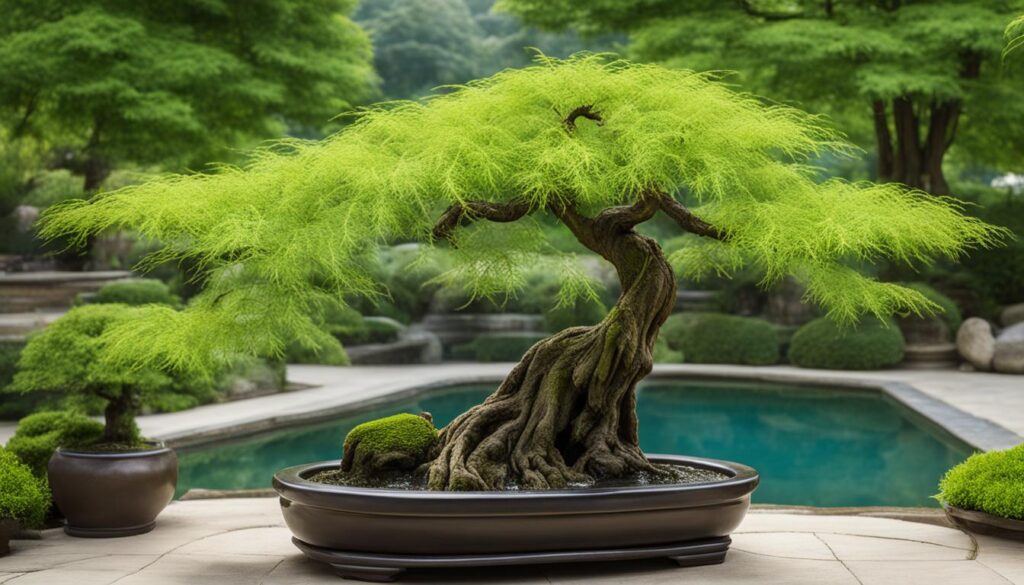
When it comes to bonsai tree species, the weeping willow bonsai (Salix babylonica) stands out with its unique traits and charm. In this section, we will explore the distinct characteristics of weeping willow bonsai trees and compare them to other willow bonsai varieties.
Unique Traits of Weeping Willow Bonsai Trees
The weeping willow bonsai is beloved for its elegant, cascading branches that create a captivating visual display. Its long, slender leaves and slender stems lend a graceful touch to any bonsai collection. Additionally, weeping willow bonsai trees have a remarkable ability to adapt to different environments and thrive both indoors and outdoors.
Salix Babylonica vs. Other Willow Bonsai Varieties
In comparison to other willow bonsai varieties, the Salix babylonica, or weeping willow bonsai, offers a unique combination of aesthetic appeal and ease of care. While most willow bonsai trees display a more upright growth habit, the weeping willow bonsai’s cascading branches create a captivating and distinctive look.
To emphasize the differences, let’s take a closer look at a table highlighting the unique traits of the weeping willow bonsai:
| Weeping Willow Bonsai (Salix babylonica) | Other Willow Bonsai Varieties |
|---|---|
| Elegant cascading branches | Upright growth habit |
| Long, slender leaves | Varying leaf shapes |
| Thrive in both indoor and outdoor environments | Preference for outdoor growth |
| Easy to care for and maintain | May require more specialized care |
As you can see, the weeping willow bonsai stands apart with its unique traits, making it a captivating choice for bonsai enthusiasts.
Choosing The Perfect Weeping Willow Bonsai
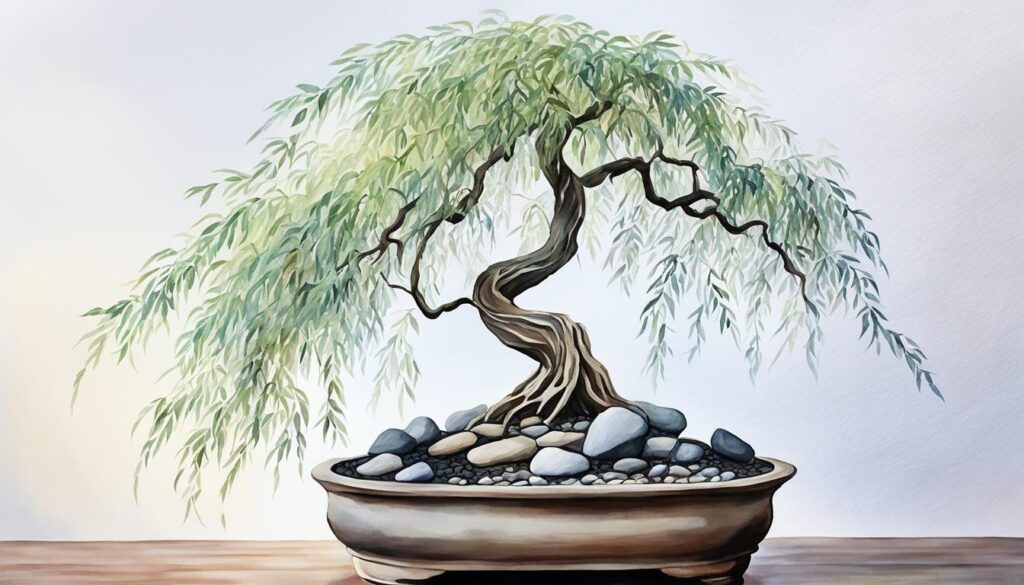
When selecting a weeping willow bonsai tree, the right choice can make all the difference in creating a stunning and harmonious display in your bonsai collection. There are a few key factors to consider to ensure you choose the perfect weeping willow bonsai that meets your preferences and requirements.
1. Size and Age
Consider the size and age of the weeping willow bonsai tree you desire. Older and larger trees can offer a more mature and dramatic appearance, while smaller and younger trees provide flexibility for shaping and styling according to your design preferences.
2. Trunk Thickness and Shape
Examine the trunk of the weeping willow bonsai tree. A thick and well-developed trunk can contribute to the overall aesthetic appeal and stability of the bonsai. Additionally, consider the shape of the trunk, whether it possesses gentle curves or more pronounced twists, as this can add character and interest to the bonsai’s design.
3. Branch Structure
Evaluate the branching structure of the weeping willow bonsai tree. Look for a tree that has well-distributed branches, with no large gaps or overcrowded areas. A balanced and harmonious branch structure will enhance the visual appeal of the bonsai and allow for proper development during the styling process.
4. Foliage Density
Inspect the foliage density of the weeping willow bonsai tree. An ideal tree will have lush and healthy foliage that is evenly distributed across the branches. Avoid trees with sparse or yellowing foliage, as this may indicate underlying health issues.
5. Overall Health
Ensure the weeping willow bonsai tree you choose is in good health. Look for signs of vitality, such as vibrant leaves, healthy roots, and absence of pests or diseases. Investing in a healthy bonsai tree will increase the chances of successful cultivation and long-term enjoyment.
| Factors to Consider | Important Considerations |
|---|---|
| Size and Age | Choose based on your desired aesthetic and styling preferences. |
| Trunk Thickness and Shape | Look for a well-developed trunk with an appealing shape. |
| Branch Structure | Ensure the branches are well-distributed and balanced. |
| Foliage Density | Opt for a tree with lush and evenly distributed foliage. |
| Overall Health | Choose a bonsai tree that displays signs of vitality and absence of pests or diseases. |
Essential Steps for Planting and Potting
When it comes to planting and potting your weeping willow bonsai, there are a few essential steps to follow. These steps will ensure that your bonsai tree has the best possible start and will set the stage for optimal growth and development.
Selecting the Right Soil Mix
The type of soil mix you choose for your weeping willow bonsai is crucial for its overall health and growth. It’s important to select a well-draining soil mix that retains moisture and provides adequate nutrients. A suitable soil mix for weeping willow bonsai may include a combination of organic materials, such as compost, peat moss, and bonsai soil mix. This blend will create a balance between water retention and drainage, allowing the roots to thrive.
Choosing a Suitable Container
Choosing the right container for your weeping willow bonsai is another important step in its planting and potting process. The container should be proportionate to the size of your bonsai tree and provide enough space for its roots to grow. Additionally, the container should have drainage holes to ensure proper water drainage and prevent root rot. A shallow and wide container is generally preferred for weeping willow bonsai, allowing ample room for its cascading branches.
Planting Techniques for Optimal Growth
When planting your weeping willow bonsai, it’s essential to follow proper techniques to promote optimal growth. Start by gently removing the bonsai tree from its nursery container, being careful not to damage the roots. Loosen the root ball and prune any damaged or tangled roots. Place the tree in the selected container, ensuring that it is centered and at the desired angle. Fill the container with the selected soil mix, gently patting it down to secure the bonsai tree in place. Finally, water the tree thoroughly to settle the soil and provide essential hydration.
Following these essential steps for planting and potting your weeping willow bonsai will create a solid foundation for its growth and ensure that it thrives in its new container. With proper soil mix selection, a suitable container, and planting techniques, your bonsai tree will have the ideal conditions for optimal growth and development.
Mastering Weeping Willow Bonsai Care
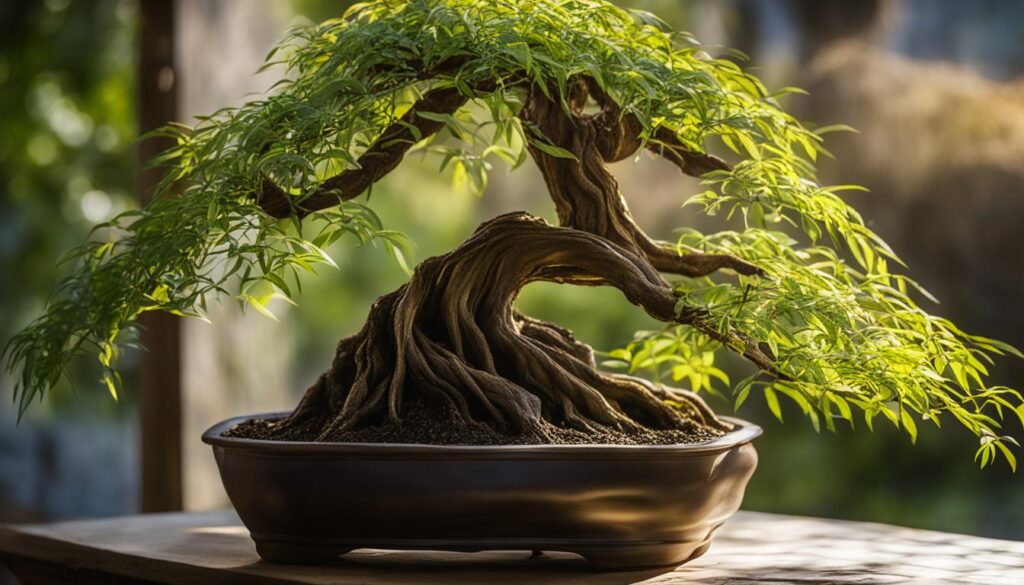
Now that you’ve chosen the perfect weeping willow bonsai and learned the essential steps for planting and potting, it’s time to dive into the art of caring for your bonsai. Proper care is crucial for the health and longevity of your bonsai, so let’s explore some care tips and techniques to help you nurture your weeping willow bonsai.
Care Tips for Weeping Willow Bonsai
- Light: Place your weeping willow bonsai in a bright location where it can receive indirect sunlight for at least 6 hours a day. Avoid placing it in direct sunlight, as it can scorch the delicate foliage.
- Watering: Maintain moist but not waterlogged soil by watering your bonsai regularly. Check the soil moisture by inserting your finger about an inch deep into the soil. If it feels dry, it’s time to water. Use a watering can or a gentle spray bottle to ensure even distribution of water.
- Humidity: Weeping willow bonsai thrives in high humidity environments. Mist the foliage regularly with water to increase humidity levels. You can also place the bonsai pot on a humidity tray filled with water and pebbles to enhance moisture around the tree.
- Pruning: Regular pruning is essential to maintain the shape and size of your weeping willow bonsai. Remove any dead, damaged, or overgrown branches using clean pruning shears. Prune during the dormant season to minimize stress on the tree.
- Fertilization: Feed your bonsai with a balanced, slow-release fertilizer during the growing season. Follow the manufacturer’s instructions for the appropriate amount and frequency of application. Fertilization helps provide essential nutrients for healthy growth and vibrant foliage.
- Pest and Disease Control: Monitor your weeping willow bonsai regularly for signs of pests or diseases. Common pests include aphids, spider mites, and scale insects. If infestations occur, treat the affected areas with appropriate insecticides or natural remedies. Additionally, maintaining good airflow and proper watering practices can help prevent disease development.
Watering Your Weeping Willow Bonsai: Techniques and Tips
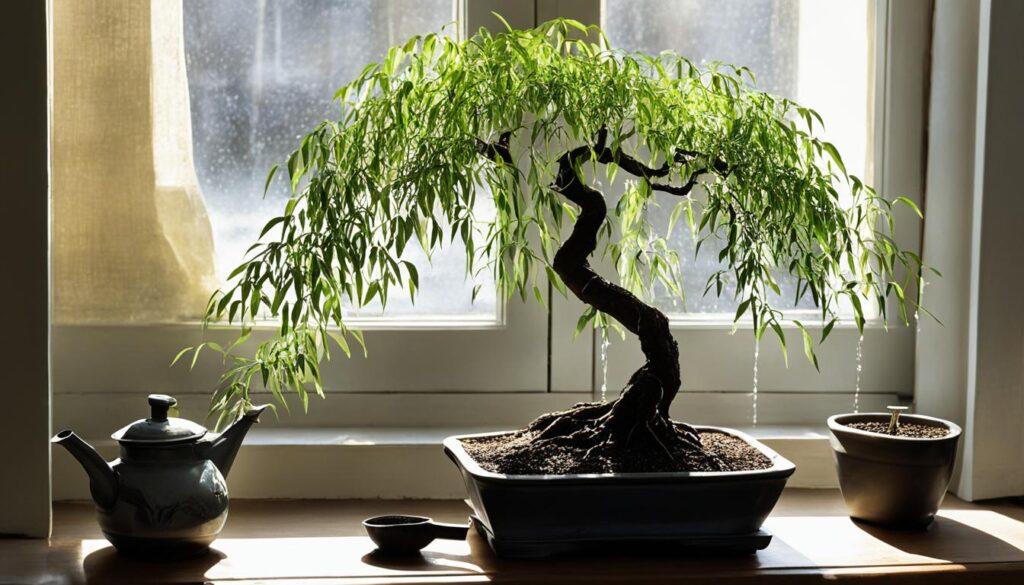
To ensure the health and vitality of your weeping willow bonsai, it is crucial to understand proper watering techniques and meet its specific water requirements. Improper watering can lead to root rot, leaf discoloration, and even the death of your bonsai. In this section, we will explore the importance of watering, techniques to follow, and how to identify signs of over or underwatering.
Understanding Water Requirements
The weeping willow bonsai has specific water needs that must be met to thrive. As a general guideline, bonsai trees should be watered when the top inch of the soil feels slightly dry. However, it’s important to consider factors such as temperature, humidity, and the size of your bonsai tree when determining its watering schedule. Adjustments may be necessary depending on the conditions in your region.
Identifying Signs of Over or Underwatering
Overwatering and underwatering both pose risks to the health of your weeping willow bonsai. It’s vital to be able to recognize the signs to take appropriate action.
Signs of overwatering:
- Yellowing or browning of leaves
- Wilting despite moist soil
- Root rot or a foul odor
Signs of underwatering:
- Wilted or crispy leaves
- Soil that feels extremely dry throughout
- Excessive leaf drop
Regular observation and checking the moisture levels of the soil are key to maintaining the proper balance of water for your weeping willow bonsai. Remember that each bonsai may have subtle variations in its water requirements, so it’s important to monitor them closely.
Feeding and Fertilizing to Nourish Your Bonsai
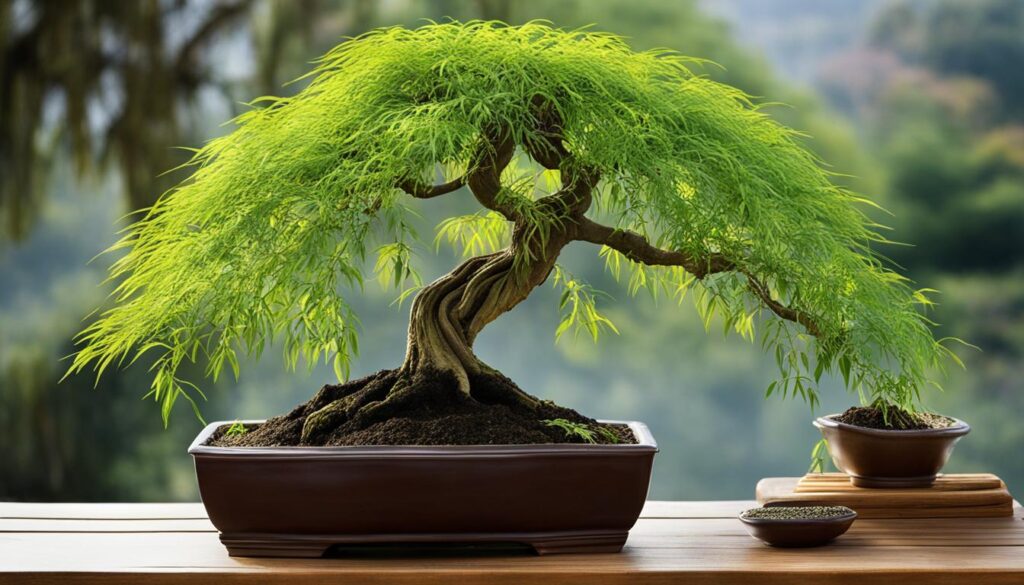
Feeding and fertilizing your weeping willow bonsai is crucial for maintaining its health and promoting optimal growth. Bonsai trees require a balanced blend of nutrients to thrive, and providing them with the right nutrition will ensure their longevity and vitality.
When it comes to feeding your weeping willow bonsai, there are a few key considerations to keep in mind:
- Choose a suitable fertilizer: Selecting the right fertilizer is essential for providing your bonsai with the nutrients it needs. Look for a balanced, slow-release fertilizer specifically formulated for bonsai trees.
- Follow the recommended dosage: Ensure you follow the instructions provided by the fertilizer manufacturer regarding dosage and application frequency. Over-fertilizing can be harmful to your bonsai, so it’s important to use the correct amount.
- Timing is crucial: Timing your fertilization is important to support the growth cycles of your weeping willow bonsai. Generally, fertilization should be done during the growing season, from spring to early autumn, to provide the necessary nutrients for robust growth.
- Consider organic options: Organic fertilizers can be a great choice for those who prefer a natural approach to bonsai care. Compost, worm castings, and seaweed extracts are popular organic options that provide a slow and steady release of nutrients.
Remember that each bonsai tree is unique, and its feeding requirements may vary. It’s essential to observe your weeping willow bonsai closely and adjust the feeding regimen based on its specific needs.
In addition to regular feeding, periodic soil testing can help determine if any specific nutrient deficiencies need to be addressed. If you notice any signs of nutrient deficiency, such as yellowing leaves or stunted growth, consider adjusting your fertilization routine accordingly.
By providing proper feeding and fertilization, you can ensure that your weeping willow bonsai receives the essential nutrients it needs to flourish and thrive.
Pruning and Styling
The art of bonsai is not only about cultivating and nurturing the perfect miniature tree but also about shaping and styling it to achieve a desired aesthetic. When it comes to weeping willow bonsai, pruning and styling play a crucial role in creating a visually appealing and harmonious masterpiece.
Pruning is an essential technique that helps maintain the size, shape, and overall health of your weeping willow bonsai. By selectively removing branches, you can enhance the tree’s form and encourage growth in desired areas. Regular pruning also promotes better airflow and sunlight penetration, ensuring the optimal development of your bonsai.
To start pruning your weeping willow bonsai, make sure you have the necessary tools such as bonsai shears, concave cutters, and branch cutters. Begin by removing any dead, damaged, or unhealthy branches. Next, focus on shaping the tree by carefully trimming back excessive growth and maintaining balance between branches. Remember to step back occasionally to assess the tree’s overall form and make adjustments as needed.
Styling your weeping willow bonsai involves creating a visually appealing composition that showcases the tree’s unique beauty. There are several styling techniques you can explore, including:
- Informal Upright: This style mimics the natural growth habit of the weeping willow, with a slightly curved trunk and cascading branches.
- Slanting: In this style, the trunk of the bonsai is angled to one side, creating a sense of movement and dynamics.
- Windswept: The windswept style imitates the effect of strong winds on the tree, with branches slanting in one direction.
- Cascade: This style resembles a waterfall, with the branches cascading down below the pot’s rim.
Each styling technique requires careful observation and artistic judgment to achieve the desired effect. You can also experiment with different wiring techniques to further refine the shape and position of branches. Just remember to handle the branches with care, as the wood of the weeping willow can be quite fragile.
By combining pruning and styling techniques, you can transform your weeping willow bonsai into a striking and captivating work of art. Enjoy the process of shaping and nurturing your bonsai, and witness the gradual transformation of a humble sapling into a breathtaking masterpiece.
Recognizing and Combating Common Pests and Diseases
While weeping willow bonsai trees are resilient and adaptable, they can still fall victim to pests and diseases. To ensure the health and longevity of your bonsai, it’s essential to be vigilant and proactive in pest control and disease prevention.
Identifying Common Bonsai Pests
Pests can wreak havoc on your weeping willow bonsai if left unchecked. Here are some common pests to watch out for:
- Aphids
- Scale insects
- Caterpillars
- Spider mites
- Mealybugs
These pests can cause damage to the foliage, weaken the tree, and stunt its growth. Regular inspections of your bonsai will help you catch any infestations early on.
Diagnosing Bonsai Diseases
Bonsai trees are susceptible to different diseases that can impair their vitality and aesthetics. Here are some common diseases that may affect weeping willow bonsai:
- Root rot
- Fungal infections
- Bacterial infections
- Leaf spot
Diseases can manifest as discoloration, wilting, or spots on the foliage. Prompt identification and treatment are crucial to prevent the spread of diseases and minimize damage to your bonsai.
Effective Pest Control and Disease Prevention
To combat pests and prevent diseases, follow these essential guidelines:
- Regularly inspect your bonsai for signs of pests or diseases.
- Isolate any infected or infested bonsai to minimize the risk of spreading pests or diseases to other trees.
- Monitor humidity levels and avoid overwatering, as excessive moisture can promote fungal and bacterial growth.
- Practice good hygiene by removing fallen leaves, debris, and deadwood, which can attract pests and contribute to disease.
- Maintain proper ventilation around your bonsai to prevent stagnant air, which can increase the risk of fungal infections.
- Apply organic or chemical treatments specifically formulated for bonsai pests and diseases, following the instructions carefully.
By implementing these pest control and disease prevention strategies, you can keep your weeping willow bonsai healthy, vibrant, and free from the harmful effects of pests and diseases.
Overcoming Challenges in Growing Indoor Bonsai
Growing indoor bonsai, such as the weeping willow bonsai (Salix babylonica), can be a rewarding and fulfilling experience. However, it is not without its challenges. To ensure the health and vitality of your indoor bonsai, you need to address these challenges head-on and implement effective care techniques. Here are some essential tips to help you overcome the challenges of growing indoor bonsai.
1. Providing Adequate Light: One of the primary challenges of indoor bonsai cultivation is providing sufficient light. Weeping willow bonsai trees thrive in bright, indirect light. Place your bonsai near a south or west-facing window to maximize natural sunlight exposure. If natural light is limited, consider using grow lights to supplement the light requirements of your indoor bonsai.
2. Regulating Temperature and Humidity: Indoor environments often have fluctuating temperature and humidity levels, which can adversely affect the health of your weeping willow bonsai. To create a suitable microclimate, maintain a consistent temperature between 65-75°F (18-24°C) and humidity levels of around 50% to 60%. You can use a humidifier or pebble trays filled with water to increase humidity levels around your bonsai.
3. Watering and Moisture Control: Overwatering or underwatering is a common challenge for indoor bonsai enthusiasts. To avoid overwatering, check the moisture level of the soil regularly. Water the bonsai only when the top inch of the soil feels slightly dry. Ensure that the pot has proper drainage to prevent waterlogging. Mist the foliage occasionally to maintain the moisture balance.
4. Managing Air Circulation: Good air circulation is crucial for the overall health of your indoor bonsai. Stagnant air can promote the growth of pests and diseases. To improve air circulation, place your weeping willow bonsai in an area with adequate ventilation. You can also use a fan to gently circulate the air around your bonsai.
By addressing these challenges and implementing the right care techniques, you can successfully grow and nurture your weeping willow bonsai indoors. Remember to observe your bonsai closely and make adjustments to meet its specific needs. With patience and dedication, you can create a beautiful and thriving indoor bonsai display.

